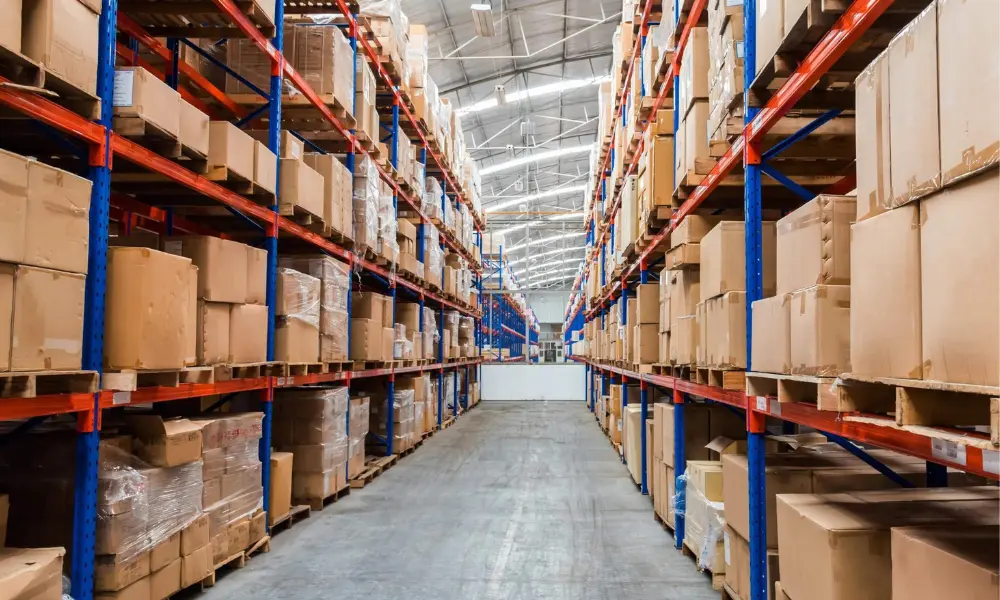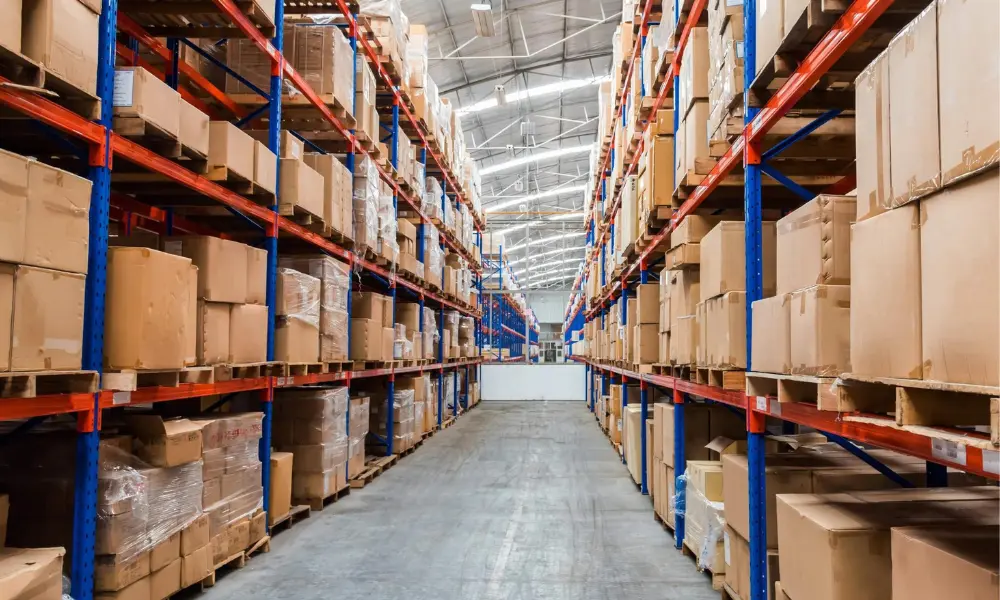In the dynamic landscape of e-commerce, efficient inventory management lies at the heart of success. Among the pivotal components of this process are the various types of warehouse that facilitate seamless operations. Understanding these warehouse types is crucial for optimizing storage, order fulfillment, and customer satisfaction.
From traditional to modern innovations like automated fulfillment centers, each variant uniquely shapes the e-commerce ecosystem. In this blog, we delve into the realm of types of warehouses, unraveling the unique characteristics and benefits they offer to empower e-commerce enterprises in their quest for operational excellence.

What Is Warehouse in E-commerce?
A warehouse in e-commerce is a central facility used to store, manage, and distribute products for online businesses. It is pivotal in ensuring efficient inventory management, order fulfillment, and customer satisfaction. Modern e-commerce warehouses have advanced technology and processes to streamline operations and improve efficiency.
Listed below are some of the critical features of an e-commerce warehouse:
- Inventory Management
Effective inventory management involves real-time tracking of product quantities, ensuring that accurate stock levels are maintained. Advanced warehouse management systems (WMS) help categorize products, track their movement, and notify when replenishment is required. This minimizes the chances of stockouts and overstock situations.
- Order Fulfillment
Order fulfillment encompasses the processes from receiving an order to shipping the product to the customer. This feature includes order picking (selecting items from inventory), packing (ensuring items are safely packaged), and shipping (choosing the appropriate carrier). An optimized order fulfillment process leads to faster delivery times and increased customer satisfaction.
- Storage Optimization
Warehouses employ various strategies to optimize storage space. Slotting optimization involves placing frequently picked items in easily accessible locations. Dynamic racking systems adjust shelf heights to accommodate different product sizes, maximizing space efficiency.
- Automation and Robotics
Automation technologies streamline operations. Conveyor systems move items within the warehouse, reducing manual handling. Robotic arms can handle repetitive tasks like picking and packing, enhancing speed and accuracy. Automated guided vehicles (AGVs) navigate autonomously to transport goods within the warehouse.
- Multi-channel Integration
E-commerce businesses often sell on multiple platforms, such as their website, third-party marketplaces, and social media. Warehouse systems integrated with these platforms ensure that orders from various sources are consolidated and processed efficiently, preventing errors and delays.
- Real-time Tracking
Advanced tracking systems provide real-time visibility into inventory levels and order statuses. This helps managers make informed decisions, anticipate potential bottlenecks, and address issues promptly. Customers can also receive accurate tracking information for their orders.
- Returns Processing
Handling returns is a crucial part of e-commerce. Dedicated areas for returns allow items to be assessed, categorized, and either reintroduced into inventory or refurbished if necessary. An efficient returns process enhances customer trust and minimizes losses due to returns.
- Security Systems
Security measures are vital to protect valuable inventory. Surveillance cameras monitor different areas of the warehouse, deterring theft and providing evidence in case of incidents. Access controls limit entry to authorized personnel, and alarm systems alert security staff in case of unauthorized access.
- Quality Control
Quality checks are essential to ensure that products meet customer expectations. Regular inspections during receiving, storage, and packing processes help identify and address defects early. This prevents defective products from reaching customers and reduces returns.
- Scalability and Flexibility
Ecommerce businesses experience fluctuations in demand, especially during promotions or holiday seasons. Scalable warehouses can adapt to changing requirements by adjusting staffing levels, storage configurations, and processing workflows. This agility enables businesses to handle peak periods efficiently.
In essence, these features collectively contribute to the smooth functioning of an ecommerce warehouse. By employing advanced technology, efficient processes, and strategic planning, ecommerce businesses can optimize their warehousing operations, resulting in improved customer satisfaction, reduced costs, and enhanced overall competitiveness.
Types of Warehouses in Ecommerce
In ecommerce, types of warehouse is pivotal in ensuring efficient order fulfillment, inventory management, and overall customer satisfaction. These facilities are designed to store and manage products before they are shipped to customers. Various types of warehouses cater to different operational needs, allowing e-commerce businesses to optimize their processes and meet customer demands effectively. Listed below are some of the types of warehouses we can keep an eye on :
- Traditional Warehouses
Traditional warehouses serve as storage spaces for a variety of goods. They can be owned or leased by businesses to store their inventory until it’s needed for order fulfillment. These warehouses are often located strategically to ensure efficient transportation and distribution.
- Distribution Centers
Distribution centers are large facilities strategically placed to facilitate the distribution of products across a specific region. They receive bulk shipments from suppliers, manufacturers, or other sources and then sort, organize, and repack these products into smaller quantities for further distribution to retail stores or directly to customers.
- Fulfillment Centers
Fulfillment centers are designed with the sole purpose of quickly and accurately processing online orders. They are equipped with advanced technology and automation to handle tasks like order picking, packing, and shipping in the shortest possible time, ensuring rapid delivery to customers.
- Cross-Docking Facilities
Cross-docking facilities minimize storage time by immediately transferring incoming goods from transportation vehicles to outbound carriers. This approach is highly efficient for products with high turnover rates or those that need to be delivered promptly.
- Temperature-Controlled Warehouses
These warehouses maintain specific temperature and humidity conditions to store products that are sensitive to environmental factors. They are crucial for items like perishable foods, pharmaceuticals, and electronics that require controlled storage to preserve quality.
- Automated Warehouses
Automated warehouses integrate technology such as robotics, conveyors, and automated storage and retrieval systems (AS/RS) to optimize order processing and inventory management. These systems enhance speed, accuracy, and efficiency in handling goods.
- Dropshipping Warehouses
In dropshipping, e-commerce businesses don’t hold inventory. Instead, when a customer places an order, the product is shipped directly from the supplier to the customer. Dropshipping warehouses manage the coordination and communication between suppliers and customers, facilitating a smooth transaction.
- Returns Processing Centers
E-commerce businesses need a system for handling returned items. Returns processing centers inspect returned products, assess their condition, and decide whether they can be restocked, repaired, refurbished, or need to be disposed of. This is crucial for maintaining customer satisfaction.
- Omnichannel Fulfillment Centers
Businesses that operate across various sales channels (online, physical stores, etc.) use omnichannel fulfillment centers to manage inventory and orders seamlessly. This ensures that customers receive consistent experiences regardless of how they choose to shop.
- Last-Mile Delivery Centers
Positioned strategically in or near urban areas, last-mile delivery centers focus on streamlining the final stages of the delivery process. They help reduce transit times and enhance the efficiency of delivering packages to customers’ doorsteps. These are important types of warehouse.
- Cooperative Warehouses
Cooperative warehouses are shared facilities owned and operated by a group of companies or retailers. They pool resources to create a centralized storage and distribution center, enabling cost savings and improved logistics for all participants.
- Private Warehouses
Private warehouses are owned and operated by a single company. They provide full control over inventory management and order fulfillment processes, allowing businesses to tailor the warehouse to their specific needs.
All types of warehouse serves a distinct purpose within the e-commerce ecosystem, catering to the diverse demands of modern online retail while optimizing various aspects of supply chain management. The choice of warehouse type depends on factors like business size, product type, geographic reach, and customer expectations.
Difference between Types of Warehouse and Distribution Center
A warehouse and a distribution center are both crucial components of the supply chain management process, but they serve distinct purposes. A warehouse primarily focuses on the storage of goods for extended periods, often acting as a long-term storage solution.
On the other hand, a distribution center is designed for the efficient and rapid movement of goods, typically acting as a hub for order fulfillment and shipping. While both facilities involve the handling of goods, their functions, layouts, and operational processes differ significantly. Both are the important types of warehouse. Listed below are some of the key differences between a warehouse and a distribution center.
- Function
A warehouse is primarily used for storing goods over longer periods, helping companies manage inventory and stock levels. A distribution center, however, is specifically designed for rapid order processing, picking, packing, and shipping of goods to customers.
- Inventory Turnover
Warehouses tend to have a lower inventory turnover rate since goods may be stored for extended periods. In contrast, distribution centers have higher turnover rates due to the constant flow of goods in and out.
- Location
Warehouses are often situated in locations that provide cost-effective storage solutions, while distribution centers are strategically located closer to major markets to facilitate quicker delivery times.
- Layout and Design
Warehouses focus on maximizing storage space, utilizing racking systems and shelving to accommodate various products. Distribution centers prioritize efficient movement, often utilizing conveyor belts, automation, and optimized picking layouts.
- Order Fulfillment
Distribution centers excel at order picking, packing, and shipping, aiming to fulfill orders swiftly. Warehouses are less optimized for rapid order processing and more for long-term storage.
- Technology and Automation
Distribution centers tend to employ advanced technologies like automated conveyor systems, robotics, and order tracking software to streamline operations. Warehouses might not require such high levels of automation.
- Staffing and Skills
Distribution centers require a workforce skilled in rapid order processing, inventory management, and logistics coordination. Warehouses may focus more on traditional inventory control and storage management skills.
- Shipping Volume
Distribution centers handle larger shipping volumes due to the nature of their operations, often dealing with direct-to-customer shipments. Warehouses generally have lower shipping volumes as their primary function is storage.
- Lead Times
Distribution centers play a crucial role in reducing lead times, ensuring that products reach customers quickly. Warehouses have less impact on reducing lead times as they are not optimized for rapid order fulfillment.
- Value-Added Services
Distribution centers often offer value-added services like kitting, customization, and repackaging to meet specific customer requirements. Warehouses typically don’t provide these services as their focus is on storage.
In summary, while both warehouses and distribution centers play vital roles in the supply chain, their distinct functions, layouts, and operational strategies set them apart. A warehouse’s emphasis on storage and a distribution center’s focus on rapid order fulfillment are critical factors that differentiate the two facilities.
Conclusion
In the dynamic realm of e-commerce, types of warehouse play a pivotal role in ensuring smooth operations. They serve as the backbone of order fulfillment, inventory management, and customer satisfaction. Understanding the diverse requirements of each e-commerce business, warehouses come in various forms, each tailored to specific needs.
From traditional brick-and-mortar warehouses to innovative automated fulfillment centers, these structures adapt to the evolving demands of the industry. In this journey of optimizing storage and distribution, solutions like Qodenext shine as a guiding light. With their expertise in streamlining e-commerce operations, Qodenext stands ready to assist businesses in embracing the most effective warehousing strategies, ultimately fostering growth and success.







